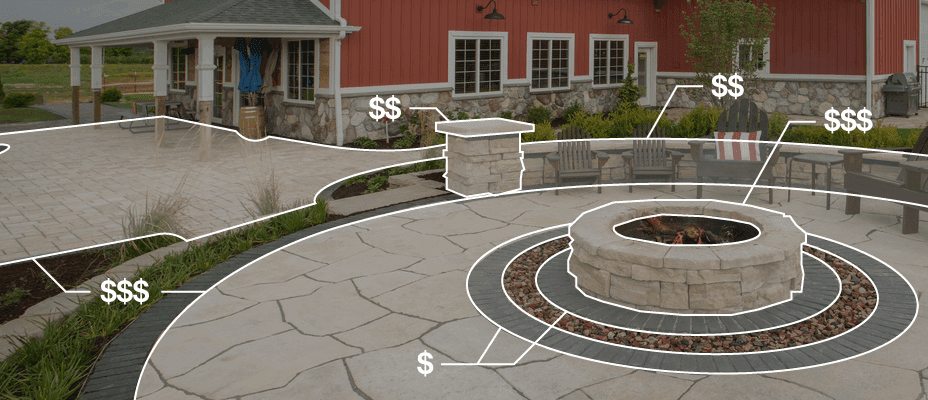Building a Budget for Your Outdoor Living Space

Avg. Read Time: ±3 min
Creating a budget for your outdoor patio involves several steps to ensure you allocate funds wisely and prioritize essential elements.
The Hardscape Highlight
Short on time? Here are this article’s key takeaways…
Break down planned expenses into categories like flooring, furniture, fixtures, and landscaping.
Save costs with DIY aspects of your project, such as building furniture, creating décor, or landscaping to save costs.
Setting aside 10-20 percent of your project budget for contingencies is key to ensure you’re not caught short should unexpected challenges arise.
Understand that construction is dynamic. Regularly review and revise your budget as the project evolves.
Here's a step-by-step guide to help you create a budget for your new outdoor living space:
1. Assess Your Finances
- Determine how much you can realistically allocate to your outdoor patio project without straining your finances.
- Consider your overall budget and any other expenses or savings goals you need to account for.
- Research the financing options available, including possibilities like a home equity loan or line of credit that allow you to borrow against the equity you’ve built in your home. These are typically attractive financing options since you’re using the borrowed money to increase your home’s value. Financing your outdoor space may help you to lessen the financial strain up front and allow you to design to your full vision.
2. Define Your Project Scope
- Determine the size and layout of your outdoor patio.
- Envision how you plan to use your space. Consider space requirements and building codes that may determine how close or far your fire features need to be from your home.
- Identify any specific features or elements you want to include, such as seating areas, dining spaces, outdoor kitchens, fire pits, lighting, landscaping, etc.
3. Research Costs
- Research the cost of materials, furniture, décor, and any additional features you want to incorporate into your patio design.
- Obtain quotes from contractors or service providers if you plan to hire professionals for installation or landscaping. If you’re unsure about how to find the right contractor, check out our Eight Tips to Find Your Next Outdoor Living Contractor article.
4. Break Down Expenses:
- Create a list of all the supplies and add-on elements you want for your outdoor living space, including:
- Flooring materials (pavers, decking, tile)
- Furniture (seating, dining sets, loungers)
- Outdoor elements (seat and garden walls, fire pits, water features, grills/pizza ovens)
- Lighting fixtures (string lights, lanterns, under-cap lighting)
- Landscaping (plants, mulch, decorative stone, edging)
5. Prioritize Your Needs
- Determine which elements are essential for your outdoor patio and prioritize them within your budget.
- Focus on allocating more funds to high-priority items while being flexible with lower-priority elements.
- Work with your contractor to determine if certain elements or areas can be completed in phases. If you’d like a grill island but it doesn’t fit in your current budget, ensure a patio layout that allows for it to be added in the future when funds are available.
6. Consider DIY Options
- Explore do-it-yourself projects for certain aspects of your outdoor patio, such as building furniture, creating décor, or landscaping.
- Calculate potential cost savings by opting for DIY solutions instead of purchasing pre-made items.
7. Account for Contingencies
- Set aside a portion of your budget for unexpected expenses or contingencies that may arise during the project. It's wise to budget 10-20% of the total project cost to cover contingencies and account for unexpected circumstances.
8. Finalize Your Budget
- Total all the estimated expenses for your outdoor patio project to determine the overall budget.
- Make any necessary adjustments to ensure your budget aligns with your available resources and project goals.
- Don’t sacrifice the quality of materials for the size of the space. Prioritizing quantity over quality has the potential to cost you in the long run.
9. Review and Revise
- Regularly review your budget throughout the planning and execution stages of your project.
- Be prepared to revise your budget as needed based on changes in costs, design plans, or unforeseen circumstances. Few home improvement projects are completed without at least a handful of hiccups. This is where your contingency budget can help cushion added costs.
The addition of a well-designed outdoor living space offers the potential to increase your home’s value by as much as 10 percent and can return almost 80 percent on your investment. By following these steps with care and forethought, you can create a realistic and manageable budget for your new outdoor patio project while ensuring you get the most value out of your investment.
